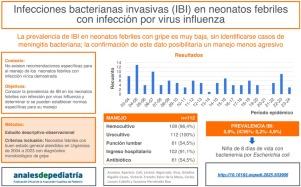感染流感病毒的发热新生儿的侵袭性细菌感染
IF 2.1
4区 医学
Q2 PEDIATRICS
引用次数: 0
摘要
确诊病毒感染的发热婴儿发生侵袭性细菌感染(IBI)的风险较低。一些作者建议对1至3个月的发热婴儿进行个体化筛查,但目前没有针对新生儿的具体建议。我们研究的目的是确定流感病毒感染的发热新生儿IBI的患病率。方法对2004-2023年间在急诊科诊断为流感的29天以下发热婴儿进行观察性描述性研究。我们排除了儿童评估三角形异常或在过去一周内接受过抗生素治疗的患者。结果共纳入112例患者。所有患者行尿培养,108例(96.4%)行血培养,61例(54.5%)行腰椎穿刺。102例(91.1%)住院,其中61例(59.8%)接受抗生素治疗。在1例患者中发现IBI(患病率0.9%;95% CI, 0.2%-4.9%):一名8天大的女孩,血液感染大肠杆菌。此外,7例(6.3%,95% CI: 3.1-12.3%)患者出现尿路感染。结论流感感染的发热新生儿IBI患病率很低,未检出细菌性脑膜炎病例。在多中心研究中确认这些结果,也可以确定相关的风险因素,将允许对低风险患者的管理采取不那么激进的方法。本文章由计算机程序翻译,如有差异,请以英文原文为准。

Infecciones bacterianas invasivas en neonatos febriles con infección por el virus influenza
Introduction
Febrile infants with a confirmed viral infection are at lower risk of an invasive bacterial infection (IBI). Several authors recommend individualizing screening in febrile infants aged 1 to 3 months, but there are currently no specific recommendations for neonates. The objective of our study was to determine the prevalence of IBI in febrile neonates with influenzavirus infection.
Methods
Observational descriptive study in febrile infants aged less than 29 days managed in the emergency department with a microbiological diagnosis of influenza over a 21-year period (2004-2023). We excluded patients with an abnormal pediatric assessment triangle or who had received antibiotherapy in the past week.
Results
The sample included 112 patients. Urine culture was performed in all, blood culture in 108 (96.4%) and lumbar puncture in 61 (54.5%). A total of 102 (91.1%) were admitted to hospital, of who 61 (59.8%) received antibiotics. An IBI was identified in one patient (prevalence 0.9%; 95% CI, 0.2%-4.9%): a girl aged 8 days with a bloodstream infection by Escherichia coli. Additionally, 7 (6.3%, 95% CI: 3.1–12.3%) patients presented with a urinary tract infection.
Conclusions
The prevalence of IBI in febrile neonates with influenza infection is very low, with no detection of cases of bacterial meningitis. Confirmation of these results in a multicenter study, which could also identify associated risk factors, would allow a less aggressive approach to the management of low-risk patients.
求助全文
通过发布文献求助,成功后即可免费获取论文全文。
去求助
来源期刊

Anales de pediatria
医学-小儿科
CiteScore
2.10
自引率
4.80%
发文量
155
审稿时长
44 days
期刊介绍:
La Asociación Española de Pediatría tiene como uno de sus objetivos principales la difusión de información científica rigurosa y actualizada sobre las distintas áreas de la pediatría. Anales de Pediatría es el Órgano de Expresión Científica de la Asociación y constituye el vehículo a través del cual se comunican los asociados. Publica trabajos originales sobre investigación clínica en pediatría procedentes de España y países latinoamericanos, así como artículos de revisión elaborados por los mejores profesionales de cada especialidad, las comunicaciones del congreso anual y los libros de actas de la Asociación, y guías de actuación elaboradas por las diferentes Sociedades/Secciones Especializadas integradas en la Asociación Española de Pediatría.
 求助内容:
求助内容: 应助结果提醒方式:
应助结果提醒方式:


